BASF secures sorbent supply for carbon capture specialist Svante
Sources: Svante Technologies, Vancouver, B.C.; CMCM staff
Svante Technologies, a partner in a carbon dioxide emissions management trials at Lafarge Canada’s Richmond, B.C. cement plant, has entered a commercial supply agreement with chemical giant BASF to process the proprietary Calgary Framework 20 (CALF-20) sorbent material. The Svante method leverages the metal-organic framework (MOF) sorbent to capture up to 95 percent of CO2 emitted from cement production and other industrial sources using rapid solid adsorption and low-pressure steam. The company has pioneered carbon capture and removal technology using structured adsorbent beds, known as “filters,” and runs the world’s first facility for commercially available MOF nanomaterial filter. Commercial scale CALF-20 volume commitments from BASF position Svante to approach multi-million-tonne filter capacity with an eye to hundreds of large-scale carbon capture and storage facilities by 2030.

BASF will process CALF-29 metal-organic framework key to Svante’s novel carbon capture filter technology. Solid sorbents are a step change for carbon capture, Svante notes, but the challenge is to merge all of their desirable features into a robust framework material with a low production cost.
“For high-performance CO2 capture and removal, steam stripping—where direct contact steam is used to flush CO2 out of the sorbent—has been a sort of ‘holy grail’ in the field. It is seen as the most effective way to do it,” says Svante CEO Claude Letourneau. “This MOF material, combined with our proprietary structured adsorption filters, is a game-changer for the carbon capture and removal industry. We have the right technology to reduce the capital cost of CO2 capture.”
The company’s solid sorbent technology concentrates CO2 from industrial flue gas into high purity, 95 percent pipeline-grade output for safe storage or further industrial use. Its unique approach is tailored specifically to the challenges of separating the compound from nitrogen in diluted flue gas, which is typically emitted in large volumes at low pressures and in dilute concentrations. Svante and BASF have worked for the last two years to scale up CALF-20, which acts as a sponge for adsorbing CO2. Results of their research, published in the international peer-reviewed journal Science (December 2021), demonstrate CALF-20’s unique resistance to oxidation and water vapor—netting low cost CO2 capture.
Related article
Partnership eyes cement plant CO2 to synfuel conversion
